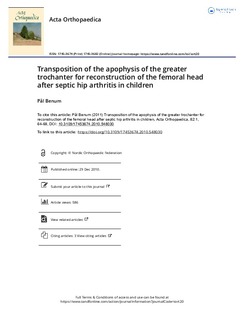| dc.contributor.author | Benum, Pål | |
| dc.date.accessioned | 2019-08-27T10:48:37Z | |
| dc.date.available | 2019-08-27T10:48:37Z | |
| dc.date.created | 2011-01-11T07:56:57Z | |
| dc.date.issued | 2011 | |
| dc.identifier.citation | Acta Orthopaedica. 2011, 82 (1), 64-68. | nb_NO |
| dc.identifier.issn | 1745-3674 | |
| dc.identifier.uri | http://hdl.handle.net/11250/2611174 | |
| dc.description.abstract | Background and purpose Total necrosis of the femoral head after infection in children during their first months of life gives a dislocated hip with severe leg shortening. A new femoral head can be achieved with subtrochanteric osteotomy and transposition of the apophysis of the greater trochanter into the acetabulum. Previous reports have dealt with short-term results (up to 12 years). Here I present some results of this procedure 15–24 years after operation.
Patients and methods 4 children aged 1–6 years with complete necrosis of the femoral head were operated on with transposition of the greater trochanter. Secondary shelf plasty was performed later in 1 child, distal femoral epiphysiodesis in another, and femoral bone lengthening in 1 child. The mean follow-up period was 19 (15–24) years.
Results A new femoral head developed in all hips. 2 of them had a spherical head with a good acetabular cover, and without any osteoarthritis except for slight reduction of cartilage height. These hips were painless, with a mobility that allowed good walking function after 16 and 24 years, respectively. In the other 2 patients, in which there was a severe acetabular dysplasia at the primary operation, the new femoral head was somewhat flattened; painful osteoarthritis led to hip replacement 15 and 21 years after trochanter arthroplasty. Even these patients had a relatively good walking function until the last couple of years before hip replacement. Maximum leg length discrepancy was 7 cm.
Interpretation Trochanter arthroplasty with subtrochanteric osteotomy in total femoral head necrosis after septic arthritis in children may give satisfactory long-term results provided adequate acetabular cover is obtained. Although the method cannot provide a normal hip, it can contribute to less length discrepancy, less pain, improved gait, and more favorable conditions for later hip replacement. | nb_NO |
| dc.language.iso | eng | nb_NO |
| dc.publisher | Taylor & Francis | nb_NO |
| dc.rights | Navngivelse-Ikkekommersiell 4.0 Internasjonal | * |
| dc.rights.uri | http://creativecommons.org/licenses/by-nc/4.0/deed.no | * |
| dc.title | Transposition of the apophysis of the greater trochanter for reconstruction of the femoral head after septic hip arthritis in children : 4 children followed for more than 15 years | nb_NO |
| dc.type | Journal article | nb_NO |
| dc.type | Peer reviewed | nb_NO |
| dc.description.version | publishedVersion | nb_NO |
| dc.source.pagenumber | 64-68 | nb_NO |
| dc.source.volume | 82 | nb_NO |
| dc.source.journal | Acta Orthopaedica | nb_NO |
| dc.source.issue | 1 | nb_NO |
| dc.identifier.doi | 10.3109/17453674.2010.548030 | |
| dc.identifier.cristin | 521317 | |
| dc.description.localcode | © Nordic Orthopaedic Federation This is an open-access article distributed under the terms of the Creative Commons Attribution Noncommercial License which permits any noncommercial use, distribution, and reproduction in any medium, provided the source is credited. | nb_NO |
| cristin.unitcode | 194,65,30,0 | |
| cristin.unitcode | 1920,9,0,0 | |
| cristin.unitname | Institutt for nevromedisin og bevegelsesvitenskap | |
| cristin.unitname | Klinikk for ortopedi, revmatologi og hudsykdommer | |
| cristin.ispublished | true | |
| cristin.fulltext | original | |
| cristin.qualitycode | 1 | |

